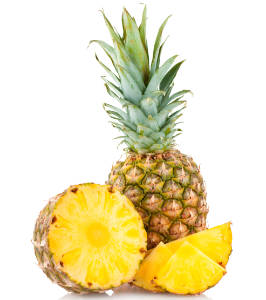Common Tropical Fruit Category

banana
Most of the bananas you and I have eaten in our lifetimes are the yellow Cavendish bananas. The burro banana = chunkey = chunky is shorter than the Cavendish, and has an interesting lemony flavor. The manzano banana is smaller yet and a bit drier, but it fits nicely into lunch boxes. The red banana has a purple peel and is best used for baking. The plantain is larger than other banana varieties, and is usually fried, baked, or mashed before eating. Yellow bananas with a few dark spots are ripe and ready to eat, while green ones will ripen at room temperature in just a few days. Refrigerating ripe bananas will keep them from getting softy and mushy, though the peels will darken.
Learn morecoconut
The most common form of coconut in markets is the dry coconut, with a hard brown shell surrounding firm coconut meat with liquid in the center. Green coconuts = water coconuts are young coconuts with very soft meat inside. They're more often found in the tropics. Select coconuts that are free of cracks or mold, that are heavy for their size, and that have lots of water in them when you shake them. To crack one, hit it along its equator with a blunt instrument, pouring off the water when the first crack appears.
Learn morefig
Varieties include Calimyrna = Smyrna and Kadota, both with green skin and pinkish-white flesh, and the most popular variety, and the Mission fig = black Mission fig, with dark purple skin and pink flesh. Dried figs are not good substitutes for fresh.
Learn moregrated coconut
Bags of grated coconuts are usually stored among the baking supplies in larger markets. Varieties include dried or desiccated coconut, flaked, angel flake, moist, sweetened and unsweetened, toasted and untoasted, and macaroon coconut. To make your own: To grate, peel off the brown skin, then grate the white flesh with a grater, food processor, or vegetable peeler. To toast, spread unsweetened grated coconut on a baking sheet and bake in a 350°F oven until coconut is golden (about 5 minutes).
Learn moremango
It's always a challenge to eat a mango. The pulp clings desperately to both peel and seed, and it can turn into a mushy mess by the time you free it. Despite this, the mango is one of the most popular fruits in the world. It's sweet and juicy, and it has a wonderful, distinctive flavor. Select richly colored, firm mangoes, then let them ripen at home for a few days. Frozen mangoes are good substitutes for fresh.
Learn morepapaya
With their subtle tropical flavor, papayas are wonderful in fruit salads, puréed fruit drinks, or even shish kabobs. They're also good for you and easy to peel and seed. Papayas from Hawaii are more common and more flavorful than those from Mexico. Yellow ones that yield to gentle pressure are ready to eat, and should be refrigerated. Green ones will ripen at room temperature in just a few days.
Learn morepersimmon
There are two varieties: the dark orange, acorn-shaped Hachiya and the light orange, tomato-shaped Fuyu. Many people have sworn off persimmons for life after biting into an underripe, astringent Hachiya. But if you wait until it's ripened to a soft, shriveled mess, you can spoon out its exquisitely sweet and delicate pulp. Fuyus aren't as flavorful, but they're more idiot-proof in that you can eat them while they're still firm and not get your mouth in a pucker.
Learn morepineapple
Pineapples are juicy, mildly acidic, and very versatile. They can be squeezed for juice, sliced on cakes, skewered and grilled, or eaten raw without adornment. Select only ripe pineapples that give a little when you squeeze them. Hard, unripe pineapples stop becoming sweeter once they're picked. A new variety, the golden pineapple, is sweeter, juicier, and richer in vitamin C than ordinary pineapples. A white pineapple also has been developed. Canned pineapple is an acceptable substitute for fresh in many recipes.
Learn morepomegranate
Cut through the pomegranate's leathery skin, and you'll find hundreds of pretty kernels, each with a tiny seed surrounded by ruby red pulp. You can eat the kernels, seeds and all, and they're great as garnishes or sprinkled in salads. You can also press the kernels for juice and strain out the seeds. Wear an apron when working with pomegranates; the juice can stain your clothes. They arrive in markets in the late summer and early fall.
Learn morestar fruit
Star fruit have a clean, crisp texture, and they make terrific star-shaped garnishes when sliced. They're also easy to use, since they don't need to be peeled or seeded, and they're slow to discolor. Some varieties are sweet, some are sour. Try to avoid ones that have brown spots or streaks.
Learn more











































































































































































































































































































































